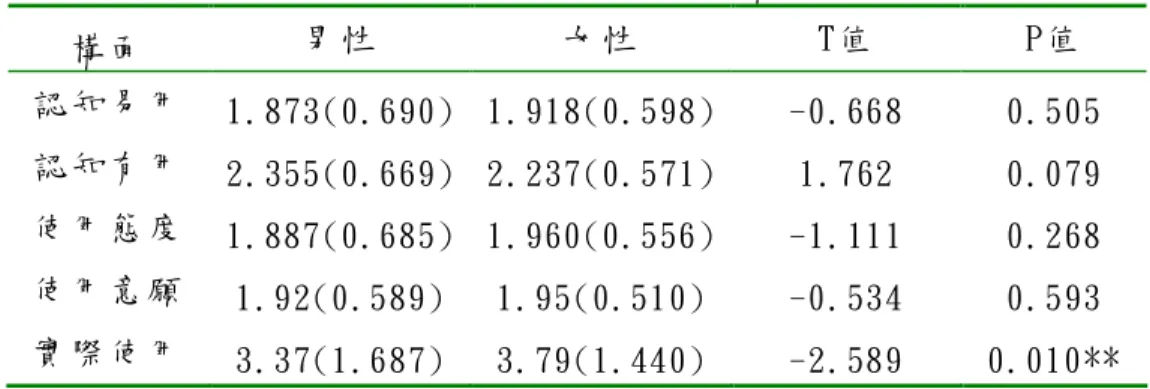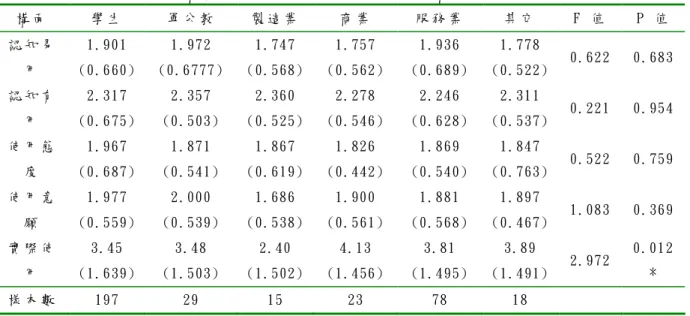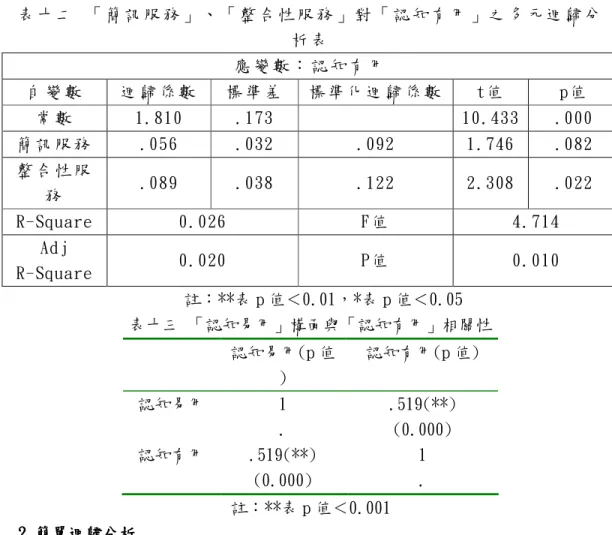The Exploration of Acceptance and Attitude
of Mobile Products and Services
Wan-I Lee, HuiHan Wei, HanChe Wu, LianHua Chen and WanYu
Chang
Department of Marketing and Distribution Management,
National Kaohsiung First University of Science and Technology
Abstract
The development of mobile technology is getting matured and customers can access the contents from the Internet via mobile devices. It is a trend to access the Internet via Notebook or Personal Digital Assistance (PDA) to use mobile products or services. Meanwhile, the function of mobile is not limited to deliver voice or picture only. The integration of multimedia service, geographic positioning service and et. al to deliver variant products or services is dramatically developed. Therefore, the well understanding of customers’ acceptance and attitude toward mobile products and services will be a great help on their promotion.
The current study applied the Technology Acceptance Model (TAM) to explore customers’ acceptance and attitude toward mobile products and services. The result reveals that geographic data of sex, education, job and cost of mobile phone are significantly different. However, the marriage, age and average time of changing mobile phones are not significantly different. Meanwhile, because the most frequent functions are data message, it shows that the mobile products and services are not widely accepted. Therefore, the mobile service providers should promote their mobile products and service more to increase the acceptance.
有很大的成長空間。行動服務的使用不只侷限於語音、圖片的傳送,還需朝向多 媒體方向發展。目前,各家行動業者皆積極推出各種行動產品與服務,以因應市 場之行動熱潮。因此,深入探討並了解消費者對於使用行動產品與服務的接受度 將有助於業者提升其服務品質與競爭力。 本研究目的在探討消費者對於使用行動產品與服務的接受度及使用意向。研 究以科技接受模型(TAM)為理論基礎,探討消費者對於行動產品與服務的認知有 用與認知易用,是否影響使用態度及使用意願,進而影響消費者的實際使用。
貳
貳
貳
貳﹒
﹒
﹒文獻探討
﹒
文獻探討
文獻探討
文獻探討
一 一 一 一﹒﹒﹒﹒行動產品與服務行動產品與服務行動產品與服務 行動產品與服務 1979 年起國內開始推出第一代(1G)的類比式行動電話,1992 年起推出第二 代(2G)的數位式行動電話,到 2001 年以後的第二點五代(2.5G)及第三代(3G)行動 電話服務系統,行動通訊技術的發展日新月異。影響行動通訊的重要技術包括無 線應用通訊協定(Wireless Application Protocol, WAP)、整合封包無線技術服務 (General Packet Radio Service, GPRS)、低功率行動電話(Personal Handy-phone System, PHS)與第三代行動通訊協定等。根據資策會(2004)調查顯示,GPRS 是消 費者使用行動與無線上網的主要連線方式(36%),其次是利用無線區域網路上網 (35%),而 3G 行動通訊服務使用的比率最低;第三代行動通訊結合了行動電話 與寬頻網路,因此具備語言、文字、靜動態影像等多媒體傳輸的能力,是目前行 動通訊服務的主流技術。3G 的傳輸速度最高可達 2Mpbs,約為 2G 的 200 倍, 且以實際資料傳輸量計價。技術連接行動電話或其他支援藍芽的裝置,例如個人數位助理(PDA)、個人電 腦。(洪昌哲,2002) 除此之外,以消費者生活為軸心出發,提供即時的行動資訊亦是目前熱門的 行動通訊產品與服務。行動資訊屬性包括線上字典、城市導覽、交通資訊、股市 報價等。在使用的費用方面,供應商與電信業者合作,消費者透過行動裝置使用 行動資訊屬性必須付通訊費用,因此,供應商可以提供更多的行動資訊屬性給消 費者。目前業者亦推出行動定位服務,主要就在幫助內容提供商評估是否能讓顧 客得到最適合的服務,顧客能在當地得到最適合的服務,而內容提供商也能夠在 當時當地提供最適合的服務給適合的顧客。如此一來,顧客、內容提供商、以及 網路提供者都能夠從中獲利。因此要達成行動定位的目標,最主要的就是能夠取 得顧客的位置(May, 2000&2002)。在眾多行動定位應用範例當中,目前全球電信 業者普遍推出的是由用戶主動索取的 Pull 服務,如指南服務,提供餐廳、加油站、 停車場、便利商店等最近點查詢,與天氣、地圖查詢等資訊;而休閒娛樂中的社 群交友服務,如找朋友、利用位置交友配對等容易引發隱私權議題,僅有少數業 者推出。另外,針對企業用戶,也有電信業者提供企業利用手機管理車隊的服務。 二 二 二 二、、、、理性行為理論與計劃行為理論理性行為理論與計劃行為理論理性行為理論與計劃行為理論 理性行為理論與計劃行為理論
理性行為理論(Theory of Reasoned Action, TRA)於 1967 年依據心理學者 Vroom 的期待價值理論發展而來,用來解釋人類行為決策過程的社會心理學理 論。1970 年代早期,Ajzen 和 Fishbein 為瞭解及預測個人行為,針對此理性行為 進行描述並做修改和擴展而應用於探討行為意願之研究。理性行為理論假設人是 理性的個體。人的思考是具有系統性的,且其行為是基於意志的控制,也就是一 個人的行為是理性而有系統的使用其所獲得的資訊,經過思考後所採取的行為。 理性行為理論主要是透過態度與行為意圖,以預測個人之實際行為。TRA 主張 信念、行為態度、主觀規範與行為意圖對個人的行為有直接或間接影響。TRA 應用不同領域,有效解釋與預測人的特定行為。此外,Davis 於 1989 年以 TRA 結合資訊系統使用的應用情境,發展科技接受模型(TAM),提供使用者在接受資 訊科技時之一般化認知行為理論基礎來有效解釋與預測資訊科技使用者之使用 行為(Davis, 1989)。 Ajzen 於 1985 年針對理性行理論的限制,將該理論加以延伸發展成計劃行 為理論(Theory of Planned Behavior, TPB),以增加 TRA 的預測能力,期望能夠 對個人控制力較弱的行為加以預測及解釋,並更具適當性。計劃行為理論與理性 行為理論的差異在於對行為意圖的預測。計劃行為理論以 (1)個人的行為意圖決 定實際行為、(2)行為態度、主觀規範及行為控制認知部分影響行為意圖;(3)行 為態度、主觀規範及行為控制認知決定於人口變數、人格特質、對標的物的信念、 對標的物的態度、參考團體、情境變數等外生變數,等來分析行為的形成過程。 三 三 三
三、、、、科技接受模式科技接受模式科技接受模式(Technology Acceptance Model, TAM) 科技接受模式
二 二 二 二 、、、 人 口 統 計 變 數 之 影 響、人 口 統 計 變 數 之 影 響人 口 統 計 變 數 之 影 響 人 口 統 計 變 數 之 影 響 在人口統計變數對認知易用、認知有用、使用態度、使用意願及實際使用分 析中,婚姻、年齡及平均換購行動裝置無顯著差異。人口統計變數對認知易用、 認知有用、使用態度、使用意願及實際使用有顯著差異之分析結果如「表三十一 」所示。 表三十一 人口統計變數與各構面關係彙整表 性別 婚姻 年齡 教育 程度 職業 平均 收入 平均 花費 換購 頻率 認知 易用 × × × ○ × × × × 認知 有用 × × × × × × ○ × 使用 態度 × × × × × ○ × × 使用 意願 × × × × × × ○ × 實際 使用 ○ × × ○ ○ × ○ × 資料來源:本研究整理 註:○表有顯著差異; X表無顯著差異
參 考 文 獻
[1] Ajzen, I. & Martin Fishbein(1980). Understanding Attitudes and Predicting
Social Behavior. Englewood Cliffs, Prentice-Hall, New Jersey.
[2] Ajzen, I. (1985). From intentions to actions: A theory of planned behavior. In J. Kuhl & J. Beckman (Eds.), Action control: From cognition to behavior. Springer-Verlag, New York.
[3] Cronbach, Lee J. (1951). Coefficient Alpha and The Internal Structure of Test.
Psychometrika, 16(3), 297-334.
[4] Cuieford (1965).Fundamental statistics in Psychology &Education. 4th Ed., New York: McGraw-Hii.
[5] Davis, F.D., R.P. Bagozzi and P.R. Warshaw (1989).User acceptance of computer technology: a comparison of two theoretical models. Management Science, 35, 982-1003.
[6] Engel, James. F., R. D. Blackwell, and P. W. Miniard (1995).Consumer Behavior. 8th, Forth Worth, Dryden Press, Texas.
Introduction to Theory and Research. M.A.: Addison-Wesley Publishing Company, Inc.
[8] Fred D. Davis, 1989.Perceived Usefulness, Perceived Ease of Use and User Acceptance of Information Technology. MIS Quarterly, 319-340.
[9] J.W. Moon and Y.G. Kim(2001).Extending the TAM for a World-Wide-Web context. Information & management ,38, 217-230.
[10] Moore, G. C., & Benbasat, I. (1991).Development of an instrument to measure the perception of adoption an information technology innovation. Information
system, 32(3), 86-112.
[11] Nunnally, J.C.(1978).Psychometric theory (2ed ed.).New York: McGraw Hii. [12] Sangjo Oh, Joongho Ahn, and Beomsoo Kim (2003).Adoption of broadband
Internet in Korea: the role of experience in building attitudes. Journal of
Information Technology, 18(4),267-280.
[13] Szajna, B. (1996),Empirical Evaluation of the Revised Technology Acceptance Model.Management Science, 42(1), 85-92.
[14] Taylor, S. & Todd, P.A. (1995b).Assessing IT Usage: The Role of Prior Experience.MIS Quarterly, 561-570.


